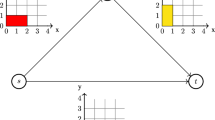Abstract
In search for market equilibrium in multicommodity markets, price-oriented schemes are normally used. That is, a set of prices (one price for each commodity) is updated until supply meets demand for each commodity. In some cases such an approach is rather inefficient, and a resource-oriented scheme can be highly competitive. In a resource-oriented scheme the allocations are updated until the market equilibrium is found. It is well known that in a two-commodity market resource-oriented schemes are possible. In this article we show that resource-oriented algorithms can be used for the general multicommodity case as well, and present and analyze an algorithm. The algorithm has been implemented and some performance properties, for a specific example, are presented.
Similar content being viewed by others
References
J. M. Akkermans, F. Ygge, and A. Andersson, ''Smart solutions: Energy management through electronic markets,'' The ISES Project Book, EnerSearch AB: Malmo, 1998, chap. 5, pp. 81–106. (Available from http://www.ene/search.se.)
A. Andersson and F. Ygge, ''Managing large scale computational markets,'' in Proceedings of the Software Technology Track of the 31th Hawaiian International Conference on System Sciences (HICSS31), H. El-Rewini (Ed.), IEEE Computer Society, Los Alamos, January 1998, vol. VII,pp. 4–14. ISBN 0–8186–8251–5, ISSN 1060–3425, IEEE Catalalog Number 98TB100216. (Available from. http://www.enersearch.se/ygge.)
J. Cheng and M. P. Wellman, ''The WALRAS algorithm—a convergent distributed implementation of general equilibrium outcomes,'' Computational Economics, vol. 12, pp. 1–24, 1998. (Available from http://ai.eecs.umich.edu/people/wellman.)
R. Fletcher, Practical Methods of Optimization, John Wiley & Sons, 1987, second edition.
G. H. Golub and C. F. Van Loan, Matrix Computation, John Hopkins University Press, 1991, second edition.
J. Hu and M. P. Wellman, ''Self-fulfilling bias in multiagent learning,'' in Proceedings of the Second International Conference on Multi-Agent Systems ICMAS'96, M. Tokoro (Ed.), AAAI Press, Menlo Park, CA, December 9–14, 1996, pp. 118–125.
B. A. Huberman and S. Clearwater, ''A multi-agent system for controlling building environments,'' in Proceedings of the First International Conference on Multi-Agent Systems ICMAS'95, AAAI Press/The MIT Press, Menlo Park, CA, June 12–14, 1995, pp. 171–176.
L. Hurwicz, ''On informationally decentralized systems,'' in Decision and Organization, C. B. McGuire and R. Radner (Eds.), University of Minnesota Press, 1986, chap. 14, pp. 297–336, second edition.
T. Ibaraki and N. Katoh, Resource Allocation Problem—Algorithmic Approaches, The MIT Press: Cambridge, MA, 1988.
J. F. Kurose and R. Simha, ''A microeconomic approach to optimal resource allocation in distributed computer systems,'' IEEE Transactions on Computers, vol. 38(5), pp. 705–717, 1989.
J. Lenting and P. Braspenning, ''An all-pay auction approach to resource allocation,'' in Proceedings of the 11th European Conference on Artificial Intelligence, ECAI'94, A. Cohn (Ed.), John Wiley & Sons, Ltd, 1994.
A. Mas-Colell, M. Whinston, and J. R. Green, Microeconomic Theory, Oxford University Press, 1995.
M. S. Miller and K. E. Drexler, ''Markets and computation: Agoric open system,'' available at: http://www.agorics.com/agorics/agoricsPapers/aos/AOS0.html, 1996.
W. Nicholson, Microeconomic Theory—Basic Principles and Extensions, The Dryden Press: Orlando, 1995, sixth edition.
V. Pan, ''How can we speed up matrix multiplication?'' SIAM Review, vol. 26, pp. 393–416, 1984.
W. Press, S. Teukolsky, W. Vetterling, and B. Flannery, Numerical Recipies in C, Cambridge University Press, 1994, second edition.
T. W. Sandholm and F. Ygge, Constructing speculative demand functions in equilibrium markets, submitted.
T. W. Sandholm and F. Ygge, ''On the gains and losses of speculation in equilibrium markets,'' in Proceeding of the Fifteenth International Joint Conference on Artificial Intelligence, IJCAI 97, August 23–29, 1997, pp. 632–638. (Available from http://www.enersearch.se/ygge.)
J. B. Shoven and J. Whalley, Applying General Equilibrium, Cambridge University Press: New York, 1992.
A. Takayama, Mathematical Economics, Cambridge University Press, 1985.
M. P. Wellman, ''A market-oriented programming environment and its application to distributed multicommodity flow problems,'' Journal of Artificial Intelligence Research, (1), pp. 1–23, 1993. (Available from http://www.jai/. org/.)
M. P. Wellman, ''A computational market for distributed configuration design,'' in Proceedings of AAAI'94, Morgan Kaufmann Publishers, San Francisco, CA, 1994, pp. 401–407. (Available from http://ai.eecs.umich.edu/people/wellman/Publications.html.)
M. P. Wellman, ''Market-oriented programming: Some early lessons,'' in Market-Based Control: A Paradigm for Distributed Resource Allocation, S. Clearwater (Ed.), World Scientific, 1996, chap 4. (More info about the book at http://www.wspc.co.uk/wspc/Books/compai_hilites.htmlambc. The paper is available from http://ai.eecs.umich.edu/people/wellman/Publications.html.)
J. E. White, ''Telescript technology: The foundations for the electronic market place,'' Technical report, General Magic Inc., 2465 Latham Street, Mountain View, CA 94040, USA, 1994.
H. Yamaki, M. P. Wellman, and T. Ishida, ''A market-based approach to allocating QoS for multimedia applications,'' in Proceedings of the Second International Conference on Multi-Agent Systems ICMAS'96, M. Tokora (Ed.), AAAI Press, Menlo Park, CA, December 9–14, 1996, pp. 385–392. (Available from http://ai.eecs.umich.edu/people/wellman/Publications.html.)
F. Ygge and J. M. Akkermans, ''Power load management as a computational market,'' in Proceed-ings of the Second International Conference on Multi-Agent Systems ICMAS'96, M. Tokoro (Ed.), AAAI Press, Menlo Park, CA, December 9–14, 1996, pp. 393–400. (Available from http:/www.enersearch.se/ygge.)
F. Ygge and J. M. Akkermans, ''An analysis of centralized control orientations vs. decentralized markets,'' 1999, accepted for publication in Journal of Artificial Intelligence Research, JAIR (http://www.jair.org.)
F. Ygge, J. M. Akkermans, A. Andersson, M. Krejic, and E. Boertjes, ''The HomeBots system and field tests: A multi-commodity market for predicitive load management,'' in Proceedings of the Fourth International Conference and Exhibition on The Practical Application of Intelligent Agents and Multi-Agents (PAAM99), April 19–21, 1999, pp. 363–382. (Available from http:// www.enersearch.se/ygge.)
F. Ygge, ''Market-Oriented Programming and its Application to Power Load Management,'' Ph.D. thesis, Department of Computer Science, Lund University, 1998, ISBN 91–628–3055–4, CODEN LUNFD6/ NFCS-1012 /1–224/(1998). (Available from http://www.enersearch.se/ygge.)
Author information
Authors and Affiliations
Rights and permissions
About this article
Cite this article
Ygge, F., Akkermans, H. Resource-Oriented Multicommodity Market Algorithms. Autonomous Agents and Multi-Agent Systems 3, 53–71 (2000). https://doi.org/10.1023/A:1010085828122
Issue Date:
DOI: https://doi.org/10.1023/A:1010085828122




